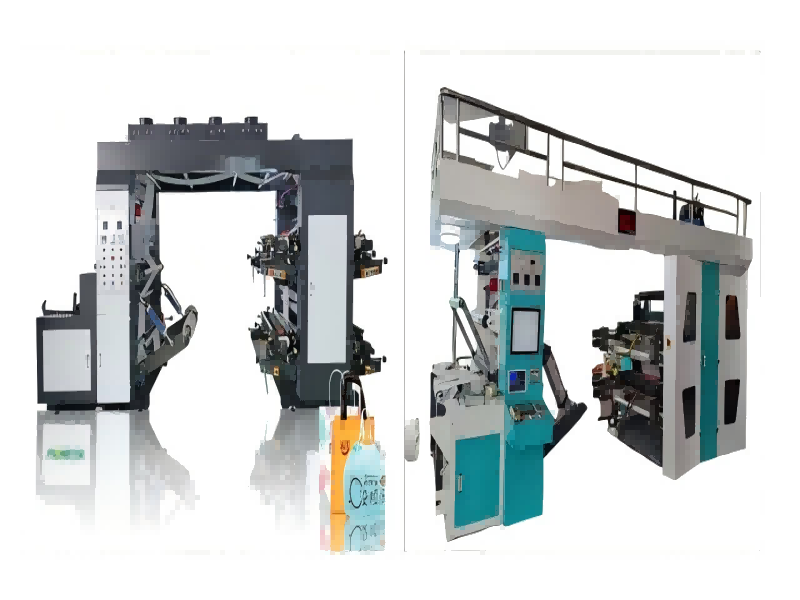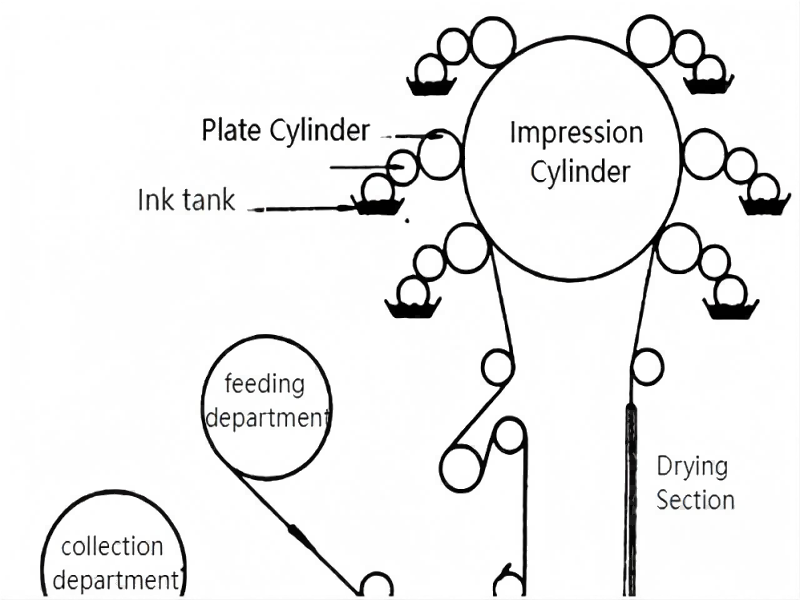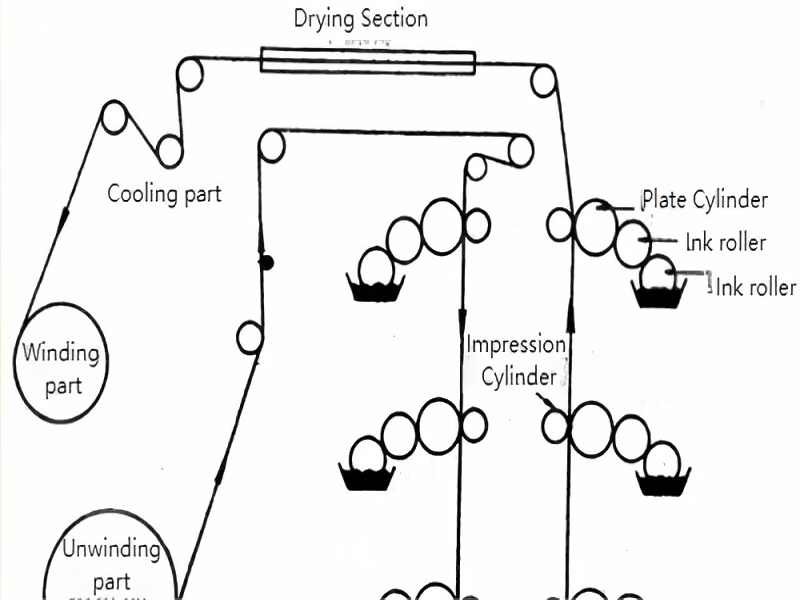
Iفي إنتاج أكياس الصمامات البلاستيكية المنسوجة، تؤثر عملية الطباعة بشكل مباشر على مظهر المنتج وملمسه وقدرته التنافسية في السوق. وباعتبارها المعدات الأساسية لطباعة الأقمشة البلاستيكية المنسوجة والأفلام المركبة، فإن التصميمات "التابعة" و"المكدسة" لآلات الطباعة بالحفر الشبكي ذات التغذية الشبكية تركز بشكل مختلف على أكياس الصمامات البلاستيكية المنسوجة. جاتشن سوف نركز على خصائص هذين النموذجين في طباعة أكياس الصمامات المنسوجة البلاستيكية لمساعدتك في العثور على أداة إنتاج أكثر ملاءمة.
تُستخدم أكياس الصمامات البلاستيكية المنسوجة على نطاق واسع في الصناعات الكيميائية ومواد البناء والأغذية وغيرها، نظرًا لمقاومتها للرطوبة وتحملها للأحمال وخواصها المانعة للتسرب. تتكون مادة الطباعة في الغالب من قماش بلاستيكي منسوج (PP/PE). يتميز سطح هذا النوع من المواد بخشونة نسبية، وسمكه موحد نسبيًا، مع درجة معينة من اللدونة، مما يتطلب متطلبات خاصة لمرونة معدات الطباعة. وفقًا لترتيب وحدة الطباعة، تنقسم آلات الطباعة بالحفر التقليدية إلى نوعين: نوع ساتلي ونوع مكدس، ولكل منهما مزاياه الخاصة في إنتاج أكياس الصمامات البلاستيكية المنسوجة.
1. آلة طباعة الحفر من نوع الويب الساتلي: "المثبت" للطباعة عالية الدقة للأكياس البلاستيكية المنسوجة ذات الصمامات
يعتبر هيكل القمر الصناعي بتصميمه الذي يشبه "جميع النجوم حول القمر" مثاليًا لطباعة أكياس الصمامات البلاستيكية المنسوجة التي تتطلب دقة طباعة عالية.
الهيكل الأساسي
تُرتَّب جميع أسطوانات ألواح الحفر حول أسطوانة طباعة مركزية، مثل أقمار صناعية تدور حول كوكب. لطباعة أكياس الصمامات البلاستيكية المنسوجة، عادةً ما يتم تصميم 4-6 وحدات طباعة لتلبية متطلبات الأنماط متعددة الألوان لمعظم المنتجات.
سير العمل
بعد فكّ المادة البلاستيكية المنسوجة الأساسية (القماش المنسوج أو الغشاء المنسوج المركب) من قسم التغذية، تدخل منطقة الطباعة عبر أسطوانة التحكم في الشد، وتلتصق بإحكام بسطح أسطوانة الطباعة المركزية، ثم تمر عبر كل وحدة طباعة بالتناوب لإكمال الطباعة الفوقية متعددة الألوان. بالنسبة لأكياس الصمامات التي تتطلب طباعة على الوجهين (مثل طباعة أنماط العلامة التجارية على الوجه الأمامي وتعليمات المنتج على الوجه الخلفي)، يمكن استخدام جهاز الطباعة العكسية لتحقيق إنتاج فعال لطباعة "لون واحد على جانب واحد + ألوان متعددة على الجانب الآخر"، ثم تُعاد لفّها في لفات بواسطة قسم الاستلام.
المزايا الأساسية للأكياس البلاستيكية المنسوجة

(١) دقة طباعة عالية وملاءمة مثالية للأسطح الخشنة: تظهر خطوط السدى واللحمة على سطح القماش البلاستيكي المنسوج. تتميز أسطوانة النقش المركزية بتصميمها الثابت، مما يُمكّن من توزيع الضغط بالتساوي على السطح، ويقلل من انحراف الطباعة الزائدة الناتج عن عدم تساوي تصميم النسيج. وهي مناسبة بشكل خاص لطباعة أكياس الصمامات ذات النصوص الدقيقة، ورموز الاستجابة السريعة، والأنماط المعقدة (مثل لافتات التحذير من المنتجات الكيميائية، وشعارات العلامات التجارية لتغليف الحبوب).
٢- تقليل تشوه تمدد الركيزة: على الرغم من أن ليونة القماش المنسوج البلاستيكي أقل من ليونة الفيلم، إلا أنه قد يتعرض لتمدد طفيف بسبب الشد غير المتساوي أثناء الطباعة عالية السرعة. يُقلل نقل الأسطوانة المفردة من النوع القمري طوال العملية بشكل كبير من خطر التمدد، ويتجنب "استطالة" أو "اختلال محاذاة" النمط.
(3)ثبات مناسب للإنتاج الضخم: تُصنع أكياس الصمامات البلاستيكية المنسوجة في الغالب بكميات كبيرة. نقطة النقش المفردة من النوع القمري تقلل من تقلبات التوتر، مما يضمن ثبات الطباعة المستمرة على المدى الطويل ويقلل من معدل الهدر.
القيود في مجال النسيج البلاستيكي
(١) تُعدّ كفاءة التجفيف صعبة على الركائز السميكة: فالأقمشة المنسوجة والأغشية المركبة تمتص كميات كبيرة من الحبر، بينما تكون المسافة بين وحدات التجميع قصيرة، ومساحة تجفيف الأحبار القائمة على المذيبات محدودة. لذا، يلزم نظام تجفيف قوي (مثل نظام تدوير الهواء الساخن عالي الحرارة)، وإلا فقد تحدث مشكلة "التلطخ".
(2) ضعف قابلية الصيانة: في الطباعة المنسوجة، تلتصق لوحة الطباعة بسهولة بزغب القماش المنسوج، وتحتاج إلى التنظيف المتكرر. ومع ذلك، فإن الهيكل المدمج للقمر الصناعي يستهلك مساحة تشغيل صغيرة، وكفاءة التنظيف وتغيير اللوحة منخفضة بعض الشيء.
ينطبق على سيناريوهات أكياس الصمام المنسوجة البلاستيكية
(1) أكياس الصمامات الصناعية (مثل أكياس الأسمنت وأكياس المواد الخام الكيميائية) المصنوعة من الأقمشة المنسوجة السميكة أو الركائز ذات الملمس الخشن؛
(2) الطلبات المخصصة التي تتطلب أنماط معقدة بأكثر من 8 ألوان أو عمليات خاصة (تغليف BOPP)؛
(3) الشركات المصنعة التي تطبع أكياس الصمامات بعرض ≥ 1 متر، أو التي تنتج ركائز متعددة مثل الورق والأقمشة غير المنسوجة.
2. آلة طباعة الحفر ذات التغذية الشبكية المكدسة: أداة متعددة الاستخدامات لإنتاج مرن لأكياس الصمامات البلاستيكية المنسوجة
تم تصميم النوع المكدس بوحدات مستقلة مثل "المكدس" وهو أكثر مرونة في الإنتاج المتنوع لأكياس الصمامات المنسوجة البلاستيكية.
الهيكل الأساسي
وحدات الطباعة مُركّبة رأسياً على لوح الحائط الرئيسي، وكل وحدة مُجهّزة بأسطوانة طباعة مستقلة، تُدار بشكل مُنتظم بواسطة نظام تروس. في صناعة النسيج البلاستيكي، يُمكن تكوين مجموعات ألوان من ٢ إلى ٨ بمرونة، كما يُمكن إضافة وحدات مساعدة مثل الختم البارد والتصفيح.
سير العمل

بعد فكّ اللفة، تمر الطبقة البلاستيكية المنسوجة عبر وحدات الطباعة المكدسة بالتسلسل وفقًا للمسار المُحدد مسبقًا، وتُكمل كل وحدة طباعة بلون واحد. بفضل المسافة الكبيرة بين الوحدات، تتوفر مساحة كافية لتمرير الطبقة عبر جهاز التجفيف بعد الطباعة قبل دخول مجموعة الألوان التالية. يمكن لقسم الاستلام اختيار إعادة اللف العادية أو الاحتفاظ بالشد لعمليات تصنيع الأكياس اللاحقة حسب الحاجة.
المزايا الأساسية للأكياس البلاستيكية المنسوجة
(1)مجفف بالكامل، مناسب للركائز السميكة: يمتص القماش المنسوج البلاستيكي كمية كبيرة من الحبر، والمسافة بين الوحدات المكدسة واسعة، ويمكن تركيب نظام تجفيف متعدد المراحل (مثل التسخين المسبق بالأشعة تحت الحمراء + التجفيف بالهواء الساخن) لضمان تجفيف الحبر تمامًا، وهو مناسب بشكل خاص للأكياس الصمامية الصناعية المطبوعة بأحبار تعتمد على المذيبات.
(2)سهولة التشغيل والصيانة: تصميم الوحدة المستقلة يُسهّل تغيير وتنظيف الألواح. عند معالجة مشكلة "تلوث الوبر" الشائعة في طباعة المنسوجات البلاستيكية، يُمكن إيقاف الآلة بسرعة للتنظيف لتقليل وقت انقطاع الإنتاج.
(3)توسعة مرنة لتلبية الاحتياجات المخصصة: غالبًا ما تحتاج أكياس الصمامات البلاستيكية المنسوجة إلى إضافة مجموعات ألوان (مثل أنماط معقدة بثمانية ألوان) أو عمليات خاصة (مثل طلاء الأشعة فوق البنفسجية المحلي لتحسين مقاومة التآكل) وفقًا لمتطلبات العميل. يمكن توسيع النوع المكدس وتكوينه بسهولة للتكيف مع دفعات صغيرة ودفعات متعددة من الطلبات المخصصة.
(4)التكيف مع الركائز ذات التنسيق العريض: بالنسبة لطباعة أكياس الصمامات كبيرة الحجم (مثل العرض ≥ 1 متر) في الصناعات الكيميائية ومواد البناء، يتمتع النوع المكدس بمزيد من المزايا في استقرار التنسيق العريض.
القيود في مجال النسيج البلاستيكي
(1) متطلبات عالية للتحكم في الشد لضمان دقة الطباعة الفوقية: تُنقل الأقمشة البلاستيكية المنسوجة بين عدة أسطوانات طباعة مستقلة عبر مسار طويل. قد يؤدي التحكم غير السليم في الشد إلى انحرافات في الطباعة الفوقية، ويتطلب ذلك نظام تحكم عالي الدقة في الشد (مثل مكابح المسحوق المغناطيسي + مستشعر الشد).
(2) متطلبات ورشة عمل زيادة ارتفاع المعدات: يؤدي هيكل التكديس الرأسي إلى ارتفاع مرتفع للمعدات، ومن الضروري التأكد من أن الورشة لديها ارتفاع أرضي كافٍ (عادةً ≥4 أمتار).
ينطبق على سيناريوهات أكياس الصمام المنسوجة البلاستيكية
(1) أكياس الصمامات الصناعية (مثل أكياس الأسمنت وأكياس المواد الخام الكيميائية) المصنوعة من الأقمشة المنسوجة السميكة أو الركائز ذات الملمس الخشن؛
(2) الطلبات المخصصة التي تتطلب أنماط معقدة بأكثر من 8 ألوان أو عمليات خاصة (تغليف BOPP)؛
(3) الشركات المصنعة التي تطبع أكياس الصمامات بعرض ≥ 1 متر، أو التي تنتج ركائز متعددة مثل الورق والأقمشة غير المنسوجة.
3. نوع القمر الصناعي مقابل النوع المكدس: مقارنة المؤشرات الأساسية لطباعة أكياس الصمامات المنسوجة البلاستيكية
بُعد المقارنة | القمر الصناعي | مكدسة |
المزايا الأساسية | دقة طباعة عالية، مناسبة للأنماط الدقيقة؛ استقرار قوي للدفعة | تجفيف كامل، مناسب للركائز السميكة؛ تشغيل مرن وتوسع سهل |
مجموعة الألوان النموذجية | 4-6 ألوان (تتوافق مع الأنماط الأكثر شيوعًا) | 2-8 ألوان (قابلة للتوسيع إلى أكثر من 10 ألوان) |
صيانة المعدات | مساحة صغيرة لتغيير الأطباق/التنظيف، مرهقة بعض الشيء عند تكرارها | وحدة مستقلة، سهلة التشغيل وتكلفة صيانة منخفضة |
الاستنتاج: مفتاح اختيار طباعة أكياس الصمامات المنسوجة البلاستيكية
لا تعتمد ماكينات الطباعة الحفرية الساتلية والمكدسة على مبدأ "هذا أو ذاك" في إنتاج الأكياس البلاستيكية المنسوجة ذات الصمامات، بل تُصمّم بدقة وفقًا لمتطلبات المنتج. إذا كان طلبك يركز على الأنماط الدقيقة، والركائز المركبة الرقيقة، واستقرار الدفعات (مثل أكياس الصمامات الصالحة للأغذية)، فإن نوع الساتلية هو الخيار الأمثل لضمان الجودة؛ أما إذا كان يركز على الركائز السميكة، والتخصيص متعدد الألوان، والإنتاج واسع التنسيق (مثل طباعة فوهة صمام الأكياس الصناعية)، فإن النوع المكدس يُحسّن مرونة الإنتاج بشكل أفضل. في صناعة الأكياس البلاستيكية المنسوجة ذات الصمامات، يكمن جوهر اختيار المعدات في "تكييف خصائص المنتج ونماذج الطلب" - فقط من خلال فهم الاختلافات الجوهرية بين النوعين الساتلي والمكدس، يمكن أن تُصبح عملية الطباعة ميزة إضافية لتعزيز تنافسية المنتج. لمعرفة المزيد، انقر على الموقع الرسمي للتواصل معنا.